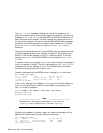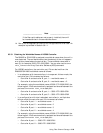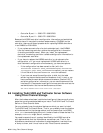
2 Prevents the command line interpreter (CLI) from reporting a
misconfiguration error resulting from not having a failover mode
set.
3 Puts the controller pair into multiple-bus failover mode. Ensure
that you copy the configuration information from the controller
known to have a good array configuration.
__________________ Note ___________________
Use the command set failover copy =
this_controller to set transparent failover mode.
4 When the command is entered to set multiple-bus failover and copy
the configuration information to the other controller, the other
controller will restart. The restart may set off the audible alarm
(which is silenced by pressing the button on the EMU). The CLI
will display an event report, and continue reporting the condition
until cleared with the clear cli command.
5 Takes the ports off line and resets the topology to prevent an error
message when setting the port topology.
6 Sets fabric as the switch topology.
12. Enter the show connection command as shown in Example 6–1
to determine the HSG80 connection names for the connections to
the KGPSA host bus adapters. For an RA8000/ESA12000 with
dual-redundant HSG80s in multiple-bus failover mode, there will be
four connections for each KGPSA in the cluster (as long as all four
HSG80 ports are connected to the same fabric).
For example, in a two-node cluster with two KGPSAs in each member
system, and an RA8000 or ESA12000 with dual-redundant HSG80s,
there will be 16 connections for the cluster. If you have other systems
or clusters connected to the switches in the fabric, there will be other
connections for the other systems. In Example 6–1, note that the !
(exclamation mark) is part of the connection name. The HOST_ID is the
KGPSA host name worldwide name and the ADAPTER_ID is the port
name worldwide name.
6–30 Using Fibre Channel Storage


















